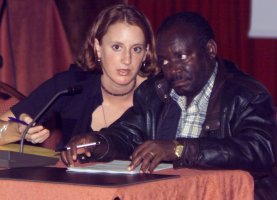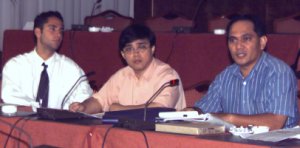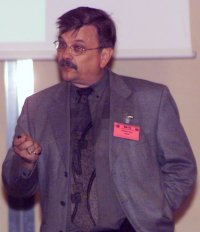|
Title:
Indigenous peoples of the tropical rainforest and the CDM
Sponsor: Climate Alliance
Contact: Gotelind Alber <g.alber@klimabuendnis.org>
Internet: http://www.klimabuendnis.org
 Representatives
of indigenous peoples' organizations in South America, North America,
the Pacific and Africa gathered at this event on the final day of
the SB-13 negotiations to report on their lobbying activities at
the Lyon meeting and exchange views on emerging climate-related
issues. There was a particular focus on issues surrounding access
to protected areas and anticipated problems linked to the development
of CDM projects. The event was convened by Lioba Rossbach de
Olmos of the Climate Alliance of European Cities. Representatives
of indigenous peoples' organizations in South America, North America,
the Pacific and Africa gathered at this event on the final day of
the SB-13 negotiations to report on their lobbying activities at
the Lyon meeting and exchange views on emerging climate-related
issues. There was a particular focus on issues surrounding access
to protected areas and anticipated problems linked to the development
of CDM projects. The event was convened by Lioba Rossbach de
Olmos of the Climate Alliance of European Cities.
Raymond
A. De Chavez (photo below, seated centre), Tebtebba Foundation,
reported a "degree of success" following his lobbying activities
in Lyon, where he raised indigenous peoples' concerns about sinks
issues, plantations, and protected areas that may be included in
territories designated as carbon sinks. Johnson Cerda, Amazon
Alliance, described how peoples inhabiting the Ecuadorian Amazon
have been rendered invisible and denied access to their lands, as
agencies pursue conservation plans but fail to manage the lands
in consultation with the inhabitants. The indigenous peoples' parliament
has decided not to recognize the designated protected areas. Turning
to the possibility of similar issues related to the designation
of lands for sequestration, he explained that indigenous peoples
would seek early consultation and agreement. A Colombian speaker
described similar experiences and invited NGOs to translate the
complex language of the CDM to enhance community understanding and
access. Alberto Yanosky, a biodiversity conservationist from
Paraguay, described a successful protected area project and invited
others to come and visit.
 Kalimba
Zephryin (photo above, seated right), Association pour la Promotion
des Batwa (APB) in Rwanda, described the expulsion of pigmy hunter
gatherers' to accommodate a forestry project funded by the World
Bank. Those who fled from the forest migrated to neighboring countries
and ended up begging for a living. Clark Peteru (photo right,
seated right), Indigenous Peoples' Biodiversity Network (Pacific)
described the impact of climate change on 5 million Pacific islanders.
On LULUCF, he described the uncertainties of sink projects and challenged
the motivations of industrialized countries seeking CDM credits
in order to continue producing greenhouse gases. On proposals to
inject carbon into the oceans, he criticized utilitarian approaches. Kalimba
Zephryin (photo above, seated right), Association pour la Promotion
des Batwa (APB) in Rwanda, described the expulsion of pigmy hunter
gatherers' to accommodate a forestry project funded by the World
Bank. Those who fled from the forest migrated to neighboring countries
and ended up begging for a living. Clark Peteru (photo right,
seated right), Indigenous Peoples' Biodiversity Network (Pacific)
described the impact of climate change on 5 million Pacific islanders.
On LULUCF, he described the uncertainties of sink projects and challenged
the motivations of industrialized countries seeking CDM credits
in order to continue producing greenhouse gases. On proposals to
inject carbon into the oceans, he criticized utilitarian approaches.
Jean
Paul Gladu (photo above, seated left), National Aboriginal Forestry
Association, described the indications and impacts of climate change
affecting the livelihoods of the Inuit people in the north and of
those in the Boreal forests to the south. He urged governments to
include indigenous peoples' representatives in their delegations
to climate change negotiations, saying it was important that governments
listen with open minds and open hearts.
Discussion:
Simone Lovera, FoE, Paraguay, raised the risk of donor funding
to forestry initiatives being side-tracked by CDM projects. Igino
Emmer, FACE Foundation, Netherlands, suggested that certification
could provide suitable standards for monitoring socio-economic impacts
arising from projects. Clark Peteru agreed but emphasized that it
is a question of opportunity cost and recommended that funds be
channelled to reducing emissions in the North. Johnson Cerda, Amazon
Alliance, confirmed that the second Indigenous Peoples' Forum would
take place at COP-6, The Hague.
Relevant
links:
National Aboriginal Forestry Association: http://www.nafaforestry.org
Fundación Moisés Bertoni: http://www.mbertoni.org.py
Climate Alliance of European Cities: http://climatealliance.org
More
information:
Raymond Chavez: <tebtebba@skyinet.net>
Johnson Cerda: <johnson@amazonalliance.org>
|
|
Title:
Agriculture's role in reducing greenhouse gases (GHG)
Sponsor: Canadian Delegation
Contact: Dr. Wayne Lindwall <lindwallw@em.agr.ca>
Website: http://www.agr.ca/policy/environment
 Glen
Hass (photo right), Soil Conservation Council of Canada, noted
that the adoption of good farming practices to develop more productive
and sustainable agriculture, also removes Glen
Hass (photo right), Soil Conservation Council of Canada, noted
that the adoption of good farming practices to develop more productive
and sustainable agriculture, also removes  from the atmosphere. He argued for the inclusion of soil sink capacity
in emissions reporting, noting that sufficient science is available
to measure, monitor, and verify the effects.
from the atmosphere. He argued for the inclusion of soil sink capacity
in emissions reporting, noting that sufficient science is available
to measure, monitor, and verify the effects.
 Dr.
Wayne Lindwall (photo left), Canadian delegation, outlined
technical details of soil carbon processes, and agriculture's potential
role in reducing GHG. He noted that globally, agriculture is a major
source of GHG, accounting for approximately 25% of Dr.
Wayne Lindwall (photo left), Canadian delegation, outlined
technical details of soil carbon processes, and agriculture's potential
role in reducing GHG. He noted that globally, agriculture is a major
source of GHG, accounting for approximately 25% of  , 50% of
, 50% of  , and 70% of
, and 70% of  emissions. He stressed that the KP should consider all potential
sinks, and supported the idea of including agricultural activities
in the KP. He said that Canada's submission comprises a broad based
accounting approach including land based activities, cropland and
grazing land management. Noting ancillary benefits, he emphasized
the positive relationship between soil carbon and increased wheat
yields.
emissions. He stressed that the KP should consider all potential
sinks, and supported the idea of including agricultural activities
in the KP. He said that Canada's submission comprises a broad based
accounting approach including land based activities, cropland and
grazing land management. Noting ancillary benefits, he emphasized
the positive relationship between soil carbon and increased wheat
yields.
Discussion:
Participants discussed the applicability of farming technologies
in developing countries, the value of carbon sequestration for developing
countries, and the socio-economic benefits of soil carbon in dry-lands
versus humid climates.
More information: A brochure describing agricultural soil
carbon sinks can be found at: http://www.agr.ca/policy/environment
|


